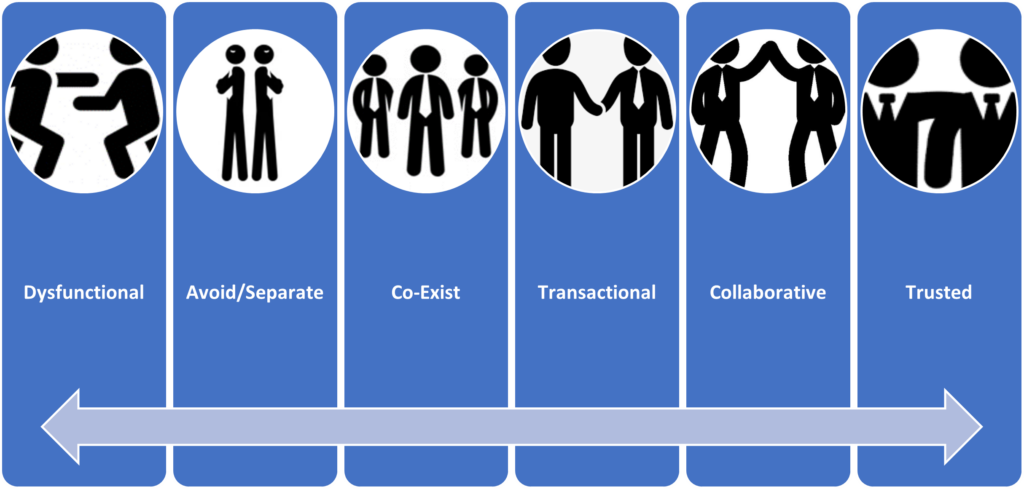Workplaces have seen significant shifts in recent years and these changes have introduced new types…

The Six Types of Working Relationships
Our relationships in the workplace often reflect how successful we will be in reaching our goals. Directive individuals may feel that this is not the case and they need only to push themselves and others harder to ensure the goal will be achieved. Workplaces are shifting away from this thinking and defining successful cultures as the ability to achieve a goal while maintaining strong working relationships – the definition of collaboration. Collaboration may not always be possible, or it may look different depending on the functionality of our working relationships.
That led me to think about the different types of relationships that we have with others in the workplace. I developed a continuum below to represent my perspective, with relationships on the left such as dysfunctional, separate or co-existing being more fractured and relationships on the right such as transactional, collaborative or trusted being stronger. Many of the relationships I am asked to support may be on the left side of the continuum, in the dysfunctional or avoid area. Sometimes working with a facilitator or conflict coach can support employees on the left to shift their relationship to the middle of the continuum to co-exist or have a more transactional relationship. Or the organization may intervene and separate employees to ensure that individuals have a psychologically safe workplace. Depending on working roles and expectations, avoiding interactions may not be a feasible solution for the long-term. When we have strong working relationships in the collaborative or trusted zone, it is often with colleagues who have the same perspective or where trust is high making cooperation easy and straightforward.
Types of Working Relationships Continuum:
 There is no right or wrong place to be on the continuum, it is a tool to build awareness of where our working relationships are and where we might want them to be. If we work comfortably in the transactional area and our work only requires this type of interaction, then all is well. If we are in a role that requires constant and extensive collaboration than we need to reach beyond transactional relationships. But what if we encounter formidable barriers to collaborating or building trust?
There is no right or wrong place to be on the continuum, it is a tool to build awareness of where our working relationships are and where we might want them to be. If we work comfortably in the transactional area and our work only requires this type of interaction, then all is well. If we are in a role that requires constant and extensive collaboration than we need to reach beyond transactional relationships. But what if we encounter formidable barriers to collaborating or building trust?
I’m in the middle of reading a book by Adam Kahane – Collaborating with the Enemy. Adam sees it like we are all trying to get something done that really matters to us. To do this we need to work with others. But these others include people we don’t agree with or like or trust, so working with them seems impossible — like collaborating with the enemy. In our workplaces we don’t often get to choose who we work or interact with. We may need to collaborate extensively regardless of our relationship dynamics, to get the job done.
Adam Kahane believes that the only way to get things done when we don’t have strong working relationships is to abandon harmony, agreement, and control and to learn to work with discord, experimentation and genuine co-creation. This a new approach to collaboration — stretch collaboration.
How do we get there? Abandoning control when you don’t trust others may be against our human nature and not aligned with how our brains work. Stretch collaboration will require support from others, neutral parties who are not invested in the outcome, but can create the space needed for achieving collaboration. Individuals who have training in conflict resolution and bring a process to build understanding and uncover interests and values. Individuals that can support participants to find solutions to the complex issues that face our workplaces and society regardless of the type of working relationship they may have. Stretch collaboration is stepping successfully into the unknown and our next important workplace challenge.
“Walker, there is no path. The path is made by walking.” – poet Antonio Machado,

Receive The Conflict Toolbox Series
The conflict toolbox series is a series of four emails with each one including a tool for your conflict resolution toolbox. After we send you the four tools, we will send you our monthly newsletter. We will always ask before sending anything else!



